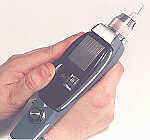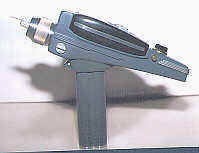Standing behind one table somewhere in the middle of the dealer's hall
sandwiched between dealers selling T-shirts, gum cards, Mego toys, & IDIC
symbols stood a studious looking young man who sometimes wore a classic Star Trek uniform. His table was basically nothing more than an order form with which you
put your name & address once you ordered his product. Most people as they
passed by his table would hear the ever popular "oohs"&"aahs"
and had to stop, curious to see what the fuss was about.
They quickly found out. This studious looking young gentleman was brandishing
a new groundbreaking item. To most people at that time, it looked like he just
walked off the Paramount lot with an original Star Trek Phaser II.
And again to most, it looked absolutely gorgeous, this pioneer copycat
was Mr. Brad Nelson. He took the time and certainly the expertise to craft his art
to almost the pinnacle of perfection for that period. "Can I see it ?"
said someone. "Wait" said Brad "Let me turn it on so you can
see what it does." Turn it on??? 
Now that was a shock. A replica that actually looks like an original
phaser, and had machined aluminum parts with all the correct trimmings to boot
was impressive enough for 1974. You mean it actually does something?? We thought
it might have had some sort of lightbulb in it, some quick light up gimmick
that he might have pulled from some kid's toy......not so!! Brad held the phaser
so the top faced him, and turned on the thumb wheel, and a light & meter
were activated. It fired beautifully with sound, was fantastically bright, and
was nothing like a lightbulb. It had 3 settings, the third being the ever popular
"overload". All the controls on this replica worked except the lock
release due to the fact that the phaser 1 was not removable because of the electronics
arrangement. 
"How did you manage to make this???" someone asked. Brad explained.
As I explained in my previous installment, like most potential
copycats, Brad noticed the poor quality replicas whenever he saw them
at shows, and knew that he could do better. He hand carved his
prototype body from wood, and made a rubber mold and cast his phasers
out of marine fiberglass. He had all the metal parts professionally
made, and then came up with an interesting idea: he put an actual
camera strobe light in it and used a working meter which came from the
audiocassette machines of the day, which was pretty close to the size
and look of the phaser meter on the original phaser. For the light
between the meter and thumb wheel, a grain of wheat light was perfect.
It had the feel and the heft of an actual weapon.









